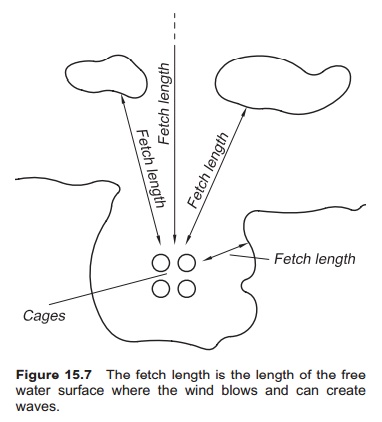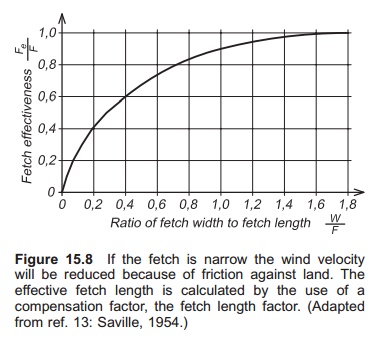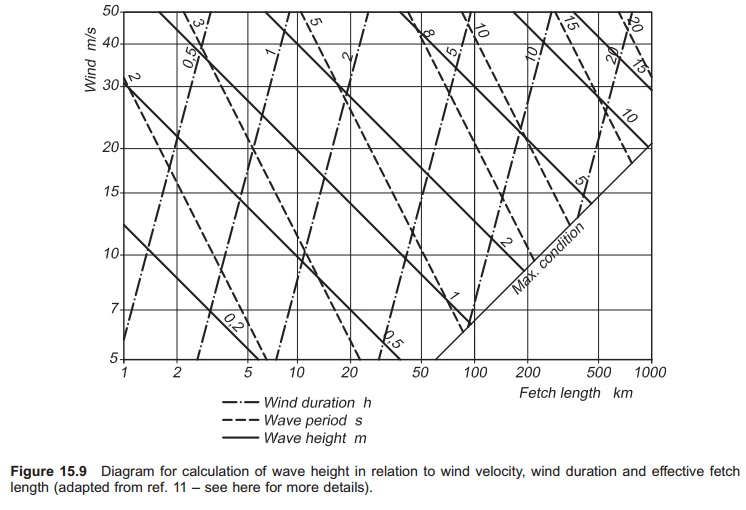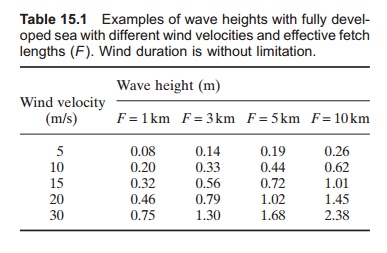Chapter: Aquaculture Engineering : Sea Cages
What creates waves?
What creates
waves?
Several factors may create waves
but the most important are:
·
Wind
·
Human activity, such as shipping
· Special natural phenomena such as
earthquakes, land slips and underwater volcanic eruptions create waves known as
tsunamis
· Tide; waves with extremely long
wavelengths are created.
Waves created by the wind are the
most relevant to aquaculture facilities and are further described below.
Shipping may also create waves that are unwanted on fish farms. To avoid such
waves, sites close to heavily trafficked sea routes should be avoided. Waves
created by exceptional natural phenomena (tsunamis) are difficult to avoid even
if such phenomena occur more frequently in some areas than others. Tsunamis
have a very long wave-length (>100 m) and a long period (around
1000 s). In such waves an enormous amount of energy is stored. They do not
represent a great danger if a boat is on the sea, because the wavelength is so long.
However, when they reach shallower water, and especially when they reach the
shore and start to break, all the energy that is stored in them is released,
and the consequences can be fatal. Such waves can be up to 30 m high when the
shoreline has forced them to increase in height to dissipate their energy; they
cause enormous destruction when they hit the shore. Waves created by the tide
normally present no problems for cage farms. The wavelength here is so long
that it is not interpreted as a wave, and the wave period is 12.5 h. Such waves
can, however, create very strong tidal currents.
Wind created waves: The main ingredient in the formation of waves on
the open ocean is wind. Wind created waves are normally also what inhibits site
selection for cage farming. When winds blow across water, a drag is applied on
the surface and pushes the water up, creating a wave. The height will increase
as long as the wind is strong enough to add energy to the wave. After a period
of time there will be equilibrium between the energy in the wind and the energy
in the waves; the wave height will now be stable. Once a wave is generated, it
will travel in the same direction until it meets land or is dampened by an
opposing force such as winds blowing against it in the opposite direction, or
by friction.
The height of wind created waves
depends on the wind velocity (Uv),
the duration of the wind (tv),
the fetch length (F) and the presence
of other waves when the wind begins to blow. The fetch length is the distance
where wave development can take place (Fig. 15.7).

The Beaufort wind scale gives the
expected wind velocity for the different wind strengths (see below). Some
scales also present the normal wave height with different wind strengths;
however, this is on open sea with no protection from land or islands.
In protected water the fetch length
where the wind can blow will limit the ability of the wind to create waves. The
fetch length can be read from a chart and is the length of the free water
surface. If the fetch where the wind is blowing is narrow, as in a fjord, the
wind effect will be less because of the friction against land on both sides
reducing the velocity. To calculate the effective fetch length a compensation
factor called the fetch length factor

Example
The length where the wind blows is 10 km and the width of the
fjord is 2 km.
Effective fetch length = fetch length × fetch length factor

In shallow water the Sverdrup–Munk–Bretsnei-der
(SMB) method may be used to estimate wave height. Formulae and diagrams have
been developed to find wave heights based on wind velocity (Uv), wind duration (tv) and effective fetch
length (Fe) (Fig. 15.9).
It must be remembered that some diagrams use the traditional sea units of foot
(ft), knot (kn) and nautical mile (nm) (1 ft = 0.3048 m; 1 kn = 0.5144 m/s; 1 nm = 1852 m).

To use the diagram in Fig. 15.9,
knowledge of the three factors, wind velocity (Uv), wind duration (tv)
and effective fetch length (Fe)
is required. First the wave height is found based on Uv and tv,
and after-wards based on Uv
and Fe. Of the two
different values found, the lower will be the wave height on the site under the
specified conditions because either wind duration or fetch length will limit
the maximum wave height. For instance, if the wind duration is short a maximum
wave height will not be attained; if the fetch length is also short it will
also inhibit maximum development of waves, even if the wind duration indicates
higher waves.
Example
Use SMB to estimate the wave height and wave period for a site
if a fresh breeze of 20 kn blows for 2 h and the fetch length is 10 nm.
First calculate wind velocity and fetch length in SI units:
20 kn= 20 × 0.5144 m/s = 10.29 m/s
10 nm = 10 × 1.852 km = 18.5 km
Using wind velocity and duration criteria and Fig. 15.9
Significant wave height = ca. 0.6 m Significant wave period = ca. 3.3 s
Using wind velocity and fetch length criteria and Fig. 15.9
Significant wave height = ca. 0.8 m
Significant wave period = ca. 3.9 s
This means that wind duration is the limiting factor for
development of waves; the wind does not blow long enough to create maximum wave
height in pro-portion to the fetch length. Critical values for the site will
therefore be:
Significant wave height = 0.6 m
Significant wave period = 3.3 s
The SMB method with the values
and diagram given above may be used for depths greater than 15 m, which is
normal in sea cage aquaculture. For intermediate depths and shallow water other
for-mulae and diagrams apply.11
In open sea conditions with no
limitation of the wind duration, the wave height will only depend on the
effective fetch length and the wind velocity. The wave height created is the
maximum possible with the given fetch length. A simplified method can then be
used to calculate wave height in shallow water11 (Table 15.1):
Hs=5.112×10−4× UA F1/2(m)
Ts=6.238×10−2(UA F)1/3(s)
UA=0.71U1.23(m/s)
where:
U = wind velocity (10 min average value 10 mabove sea level) (m/s)
UA=adjusted wind velocity (m/s)
F = fetch length (m)
Hs = significant wave height (m)
ts = significant wave period (s).

The following may be used to estimate the maximum wave height from the significant wave height:
Hmax=1.9Hs
Example
Use the simplified method to calculate the significant wave
height and wave period for a near gale with wind velocity of 15 m/s and fetch length of 3 km.
UA=0.71×27.96= 19.9 m/s
Hs=5.112×10−4×19.9×30001/2= 0.56 m
Ts=6.328×10−2×(19.9×3000)1/3= 2.44 s
Swell: Swell comprises wind generated wavescreated far away, which can
also be called ocean waves; these may also affect cage farms when they come in
from the sea. This is another reason for sitting cage farms in sheltered
positions behind holms and breakwaters. Swells are characterized by quite large
wave heights and long wavelengths. A swell can be recognized by its higher wave
period compared to a local wind generated wave: typical swell periods are in
the range 9–20 s, compared with 2–11 s for wind generated waves.
Related Topics